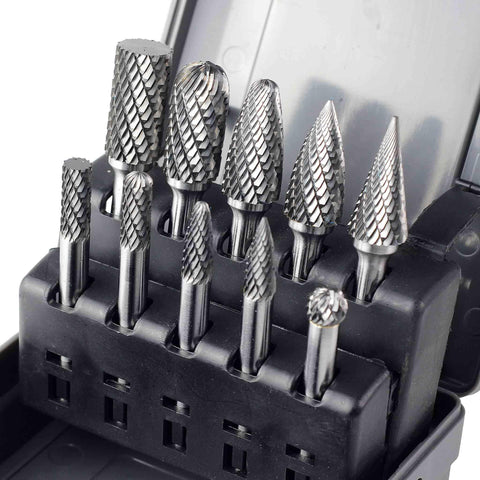
Exploring the Different Types of Burrs: A Comprehensive Guide
Burrs are essential rotary tools used across a variety of industries for cutting, shaping, grinding, and finishing materials. They are commonly utilized in metalworking, woodworking, jewelry making, and even in dental applications, providing precision and control when working with intricate or rough surfaces. Burrs come in a wide array of shapes, each tailored to specific tasks, enabling professionals and craftsmen to perform detailed work efficiently. Selecting the right type of burr for a particular project ensures that the task is completed with precision, speed, and a high-quality finish.
One of the most widely used types of burrs is the cylindrical burr. This burr features a straight, cylindrical shape, making it perfect for working on flat or slightly curved surfaces. Cylindrical burrs are ideal for surface grinding, deburring, and removing material from flat sections of metal or wood. They are often used to smooth weld seams or level out uneven areas in preparation for further machining or finishing. The uniform material removal they offer is critical in creating smooth, professional surfaces, especially when working on large metal parts or wood planks where consistency is essential.
Ball-shaped burrs are another commonly used type, especially in industries that require fine detailing and precision work. Their spherical design allows them to work smoothly over curved surfaces, making them perfect for carving, engraving, or shaping rounded edges. Ball burrs are ideal for creating concave shapes or working in recessed areas that require a delicate touch. These burrs are frequently used in jewelry making, sculpture, and metal artistry, where intricate designs and patterns are common. Their ability to navigate complex curves makes them indispensable when working with detailed engravings or soft materials like gold, silver, or aluminum.
Cone-shaped burrs provide versatility in creating angles, grooves, and chamfers on various surfaces. The tapered design of cone burrs makes them effective for reaching into tight corners or narrow spaces, allowing for precision in tasks that require deep cuts or beveled edges. They are frequently used in applications like mold-making, die-casting, and precision engineering, where accuracy in shaping or cutting small areas is crucial. Cone burrs also excel at engraving or cutting sharp details into both metal and wood, giving craftsmen the ability to work with fine details while maintaining control over the material.
Tree-shaped burrs, available in both pointed and rounded variations, are highly effective for working on internal cuts or shaping complex designs. Pointed tree burrs are designed for making sharp grooves, cutting into narrow spaces, or working on intricate areas where precision is required. Rounded tree burrs, on the other hand, are better suited for contouring and smoothing curved surfaces. These burrs are often used in die-making and cast finishing, where detailed internal work is necessary. Their shape allows them to perform detailed work inside tight or hard-to-reach areas, making them valuable for both metalworking and woodcarving projects.
Flame-shaped burrs are another key type that offers versatility and control when working on a variety of surfaces. Their unique flame-like design tapers to a point, making them useful for shaping irregular surfaces or creating smooth transitions between different parts of a workpiece. Flame burrs are commonly used in automotive repair, where the removal of excess material from metal parts must be done with care and precision. They are also favored by metal sculptors and fabricators for their ability to handle both detailed shaping and aggressive material removal.
Taper burrs are similar to cone burrs but feature a more gradual taper, making them ideal for cutting or grinding larger angles. They are often used to shape and finish curved surfaces or to create chamfers and bevels on both metal and wood. Taper burrs are effective in tasks that require long, even cuts, particularly in larger workpieces where control over material removal is necessary.
The cutting pattern of a burr is as important as its shape when determining its effectiveness for a specific task. Double-cut burrs, which feature a cross-cut pattern, are designed for smoother cutting and reduced vibration. This makes them ideal for tasks that require finer control and a polished finish, especially when working with hard materials like stainless steel or cast iron. Double-cut burrs also offer faster material removal while minimizing the risk of clogging, making them suitable for both rough cutting and detailed finishing. Single-cut burrs, by contrast, provide a more aggressive cutting action, making them perfect for rapid material removal on softer metals like aluminum, brass, or copper.
Choosing the right type of burr is crucial for ensuring efficiency and precision in any project. Whether you're grinding flat surfaces with a cylindrical burr, engraving intricate designs with a ball burr, or creating sharp edges with a cone burr, each type serves a specific purpose. The right combination of shape and cutting pattern enables craftsmen to achieve professional results, whether working on metal, wood, plastic, or softer materials. A well-rounded collection of burrs ensures that you're prepared for any task, from rough material removal to the fine details of finishing work.
Burrs are versatile, durable, and efficient tools that play a crucial role in a wide range of applications. Understanding the different types available and their specific uses is key to mastering precision work, whether you're a professional machinist, a woodworker, or an artist. Each burr shape offers unique advantages, ensuring that your project can be completed with the highest level of accuracy and quality.
